
NTS 50th Anniversary Newsletter
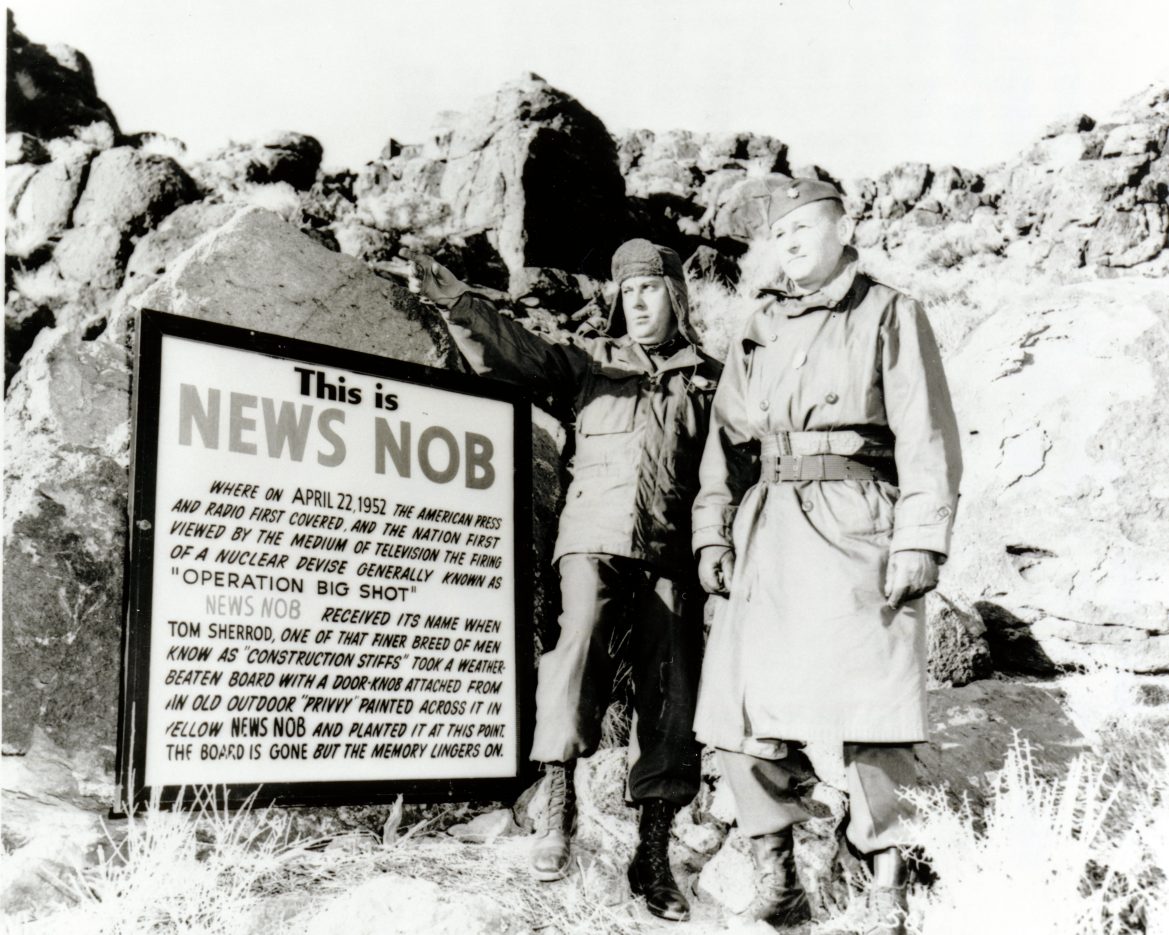
This anniversary issue of the NTS News & Views, converted to webpage form below, is dedicated to the thousands of men and women at the Nevada Test Site (NTS), who, for 42 years, have provided this nation with a safe, strong, and effective nuclear deterrent.
This issue spotlights major events at the NTS from 1951 through 1993. To pay tribute to every organization and individual who played a role in the development of the NTS during the past 42 years would be impossible. As you read these stories, remember none of the projects would have been possible without the talents of our employees. This is their story – not about a piece of real estate known as the Nevada Test Site, but about people who can all be proud of their past and future contributions to the nuclear weapons testing program and its role in keeping world peace:
- A Historical Perspective
- Camp Desert Rock
- Test site becomes mecca to international press
- Typical American community destroyed at Test Site to test Civil Defense protection for nuclear attack
- Project Pluto studied nuclear ramjet propulsion
- Sedan tested use of nuclear explosives to move earth
- MX missile, shelter, launch methods undergo testing
- Accident traps four workers 1,800 feet below ground
- Security played crucial role
- At 1,527 feet, BREN Tower dominates Test Site skyline
- NASA’s Apollo astronauts use Test Site craters to prepare for Moon surface
- Protestors dress style changes; message doesn’t
- Smoky
- Tunnel tests span 35 years of Nevada Test Site history
- Huron King
- Nuclear Rocket Development Station tested nuclear rocket for Mar mission
- Unique 36-acre experimental farm tested crops, animals
- Frenchman Flat
- Underground testing perfected big-hole drilling technology
- Yucca Mountain studies authorized in 1976
- Emergency response personnel conduct joint exercise
A Historical Perspective
Before the Nevada Proving Grounds (NPG) – forerunner of the Nevada Test Site – was established, five tests ranging in size from 18 to 49 kilotons had been conducted at Bikini and Enewetak Atolls in the Pacific Ocean from June 1946 through 1948. However, with the outbreak of hostilities in Korea in 1950, renewed attention was focused on the need for a continental test site.
Relying on a top-secret feasibility study code-named “Nutmeg,” conducted in 1946 by the Pentagon, the Atomic Energy Commission (AEC) selected the Las Vegas Bombing and Gunnery Range.
The Southern Nevada site was selected from a list of five possibilities which included Alamogordo/White Sands, New Mexico; Dugway Proving Ground, Utah; Pamilco Sound/Camp Lejuene, North Carolina; and a 50- mile-wide strip between Fallon and Eureka, Nevada.
The AEC made the final selection based on existing favorable conditions: the site was already under government control, it was a large area, had little rainfall, a low population density, and would be easy to protect against penetrators.
President Harry S. Truman approved the establishment of the NPG on December 18, 1950, and on January 27, 1951, the first atmospheric test was detonated 1,060 feet above the surface of Frenchman Flat.
Named “Able” the one- kiloton device was part of the Operation Ranger series, which consisted of five detonations ranging in size from one to 22 kilotons. All five devices were dropped from B-50 bombers that flew out of Kirtland Air Force Base, Albuquerque, New Mexico.
The Ranger series of tests went well until “Baker-2” was detonated on February 2. The eight-kiloton device broke several store windows in Las Vegas. Despite this the operation was called a success.
When the Ranger Series ended in 1951, AEC initiated plans to expand the Test Site facilities. Construction began on utility and operational structures, including communications, a control point, and additional accommodations.
As a safety measure, AEC decided to move the testing area from Frenchman Flat to Yucca Flat, where 12 areas were developed for air drops, tower, surface, tunnel and balloon tests.
Mercury, the Test Site base camp, was expanded; a Post Office opened on March 1, 1952.
South of Mercury the U.S. Sixth Army, headquartered at The Presido, San Francisco, California, established Camp Desert Rock (near the present day Desert Rock Airport). It was largely a tent camp with a few semi-permanent structures. During non-test periods the camp was home to about 100 people. During the 1955 Operation Teapot series of tests conducted at Yucca Flat, camp population exceeded 5,000 military personnel.
One noteworthy test was “Annie.” The press named it “Shamrock” because it was fired on March 17, 1953 – St. Patrick’s Day. Troops and reporters who took part dubbed it “Survival City” and “Doom Town.” Scientists built a typical, small American community near ground zero, complete with mannequins, automobiles, and a school bus. The test was to study the impacts of a nuclear blast.
In the early years of the test program, scientists and technicians responsible for each test series traveled from Albuquerque, New Mexico to Nevada, and other locations throughout the U.S., usually about a month before the first test.
At the end of each series they returned to Albuquerque to plan the next sequence of tests and experiments.
The United States conducted 100 atmospheric nuclear tests at the NTS from 1951 to 1962. The nuclear devices were dropped from planes, detonated at or near ground level, shot from a 280-mm cannon, placed on towers, and suspended from balloons.
On October 31, 1958, President Dwight D. Eisenhower declared a moratorium and stopped all testing; the Soviet Union quickly followed in November 1958. However, in September 1961, the Soviet Union unexpectedly resumed testing with a series of 50 detonations. That forced the United States to respond and on September 15, 1961, scientists began a series of nine low yield underground experiments at Yucca Flat. Sixty-two tests were conducted at the Test Site in 1962.
The increased year-round testing schedule made it necessary to establish the Nevada Operations Office which officially opened in Las Vegas on March 6, 1962.
On August 5, 1963 the Limited Test Ban Treaty was signed in Moscow prohibiting testing in outer space, underwater or in the atmosphere.
Another important milestone was the signing of the Threshold Test Ban Treaty (TTBT) by President Richard M. Nixon on July 3, 1974, in Moscow. The TTBT, which limited all nuclear tests yields to less than 150 kilotons, was not ratified by the U.S. until September 25, 1990.
On October 2, 1992, President Bush signed a nine-month moratorium stopping all nuclear testing until July 1, 1993. On July 3, 1993, President Bill Clinton pledged to extend the moratorium on nuclear weapons testing until October 1994, as long as no other nation tests.
As of December 7, 1993, the United States had announced 1,054 nuclear tests. Of these, 928 (including 24 joint U.S.-United Kingdom tests) were conducted at the NTS.
While the Test Site and its employees await the future, the next 30 pages will take you back through 42 years of the history that has played such an important role in maintaining peace through strength.
Camp Desert Rock
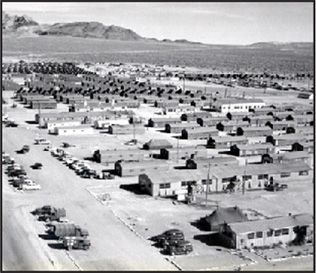
Camp Desert Rock, also known as Desert Atom Camp, Nevada, was home to the U.S. Army’s Atomic Maneuver Battalion in the 1950s. More than 2,300 soldiers were trained here in 1955. The 100 semi-permanent buildings and more than 500 tents often were filled to the 6,000 personnel capacity.
Desert Rock Airport, with its 7,500 foot runway, was built on the former Camp Desert Rock. At peak operation Camp Desert Rock comprised of 100 semi-permanent buildings, more than 500 tents and some 6,000 troops under the command of the U.S. Sixth Army, Presidio, San Francisco, California.
The camp was activated in the Fall of 1951 for the Buster-Jangle series of seven atmospheric tests. The facility continued through the Operation Teapot series in the spring of 1955.
The troops, from all four services, were deployed. Many observed the detonations from trenches, tanks and armored personnel carriers at distances of 2,500 to 7,000 yards.
Military officials declared the maneuvers invaluable for the training and orientation of troops and commanders in using essential personnel and equipment protection measures. The exercises also provided experience with atomic weapons and ground forces under simulated atomic combat conditions, both offensive and defensive.
Camp Desert Rock Related Document
Test site becomes mecca to international press
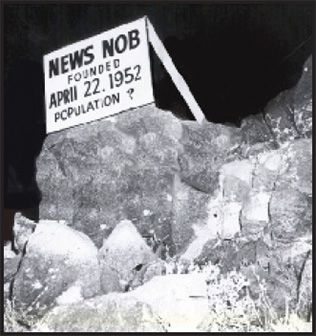
A craggy knoll of rock just across from the Control Point has its own place in the history of the Nevada Test Site. On April 22, 1952, it was established as a good point for news reporters, photographers, and cameramen to watch and film the air drop and detonation of “Charlie” (known as Operation “Big Shot”), a 31-kiloton atmospheric test at Yucca Flat.
The original sign naming the rocky outcrop “News Nob” was a weather-beaten board with a door knob attached from an old outdoor privy. The name “News Nob” was painted in yellow. Later the board was replaced with a more conventional sign, which still stands today.
Reporters witnessing shots from this vantage point included such famous national newsmen as Bob Considine, from the New York Times, and Walter Cronkite of CBS News who broadcast to the world from this spot. Since then, hundreds of reporters, photographers and cameramen from all over the world have visited “News Nob” and other sites on their tours of this the nation’s only active nuclear weapons testing facility.
While no records have been kept on the number of journalists who have visited the Test Site, it would not be exaggerating to say that during the atmospheric testing days, it was one of most photographed and heavily reported areas in the world.
Typical American community destroyed at Test Site to test Civil Defense protection for nuclear attack
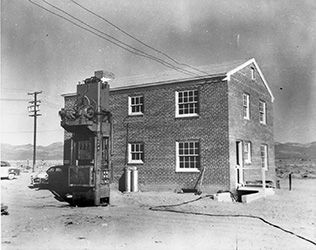
On May 5, 1955, a 29-kiloton device named “Apple II” was detonated from a 500-foot tower on Yucca Flat.
It was the second nationally televised nuclear test associated with an extensive civil effects program. The first shot was “Annie” on March 17, 1953. Annie was part of a civil effects test named Operation Cue, conducted by the Federal Civil Defense Administration (FCDA).
The FCDA completed 40 separate projects in Operation Cue. All were designed to evaluate the effects of nuclear detonations on civilian communities and to test the emergency response capabilities of Civil Defense organizations.
The FCDA constructed “a typical American community” complete with houses, utility stations, automobiles, furniture, appliances, food, and even mannequins simulating the people who might live in the town.
The houses were constructed of different materials with varied exteriors, and were heavily instrumented. Fresh food was flown in from San Francisco and Chicago and placed with the mannequins in kitchens and dining rooms throughout the test area.
Today, only the shells of two houses remain, one of brick and one wood frame building; all other structures were destroyed by the explosive force of the test.
Project Pluto studied nuclear ramjet propulsion
On January 1, 1957, the U.S. Air Force and the Atomic Energy Commission selected the Lawrence Livermore National Laboratory’s (LLNL) predecessor, the Lawrence Radiation Laboratory, to study the feasibility of applying heat from nuclear reactors to ramjet engines.
This research became known as “Project Pluto” and was moved from Livermore, California to new facilities constructed for $1.2 million on eight square miles of Jackass Flats at the Nevada Test Site (NTS).
The complex consisted of six miles of roads, critical assembly building, control building, assembly and shop buildings, and utilities. Also required for the construction was 25 miles of oil well casing which was necessary to store the million pounds of pressurized air used to simulate ramjet flight conditions for Pluto.
The work was directed by Dr. T.C. Merkle, leader of the laboratory’s R-Division.
The principle behind the ramjet was relatively simple: air was drawn in at the front of the vehicle under ram (under great force) pressure, heated to make it expand, and then exhausted out the back, providing thrust.
The notion of using a nuclear reactor to heat the air was fundamentally new. Unlike commercial reactors, which are surrounded by concrete, the Pluto reactor had to be small and compact enough to fly, but durable enough to survive a 7,000 mile trip to a potential target.
The success of this project would depend upon a series of technological advances in metallurgy and materials science. Pneumatic motors necessary to control the reactor in flight had to operate while red-hot and in the presence of intense radioactivity. The need to maintain supersonic speed at low altitude and in all kinds of weather meant the reactor, code named “Tory,” had to survive temperatures of 2,500 degrees Fahrenheit, and conditions that would melt the metals used in most jet and rocket engines.
On May 14, 1961, the world’s first nuclear ramjet engine, “Tory- IIA,” mounted on a railroad car, roared to life for just a few seconds. Despite other successful tests the Pentagon, sponsor of the “Pluto project,” had second thoughts. On July 1, 1964, seven years and six months after it was born, “Project Pluto” was canceled.
Project Pluto Related Document
Sedan tested use of nuclear explosives to move earth
The Atomic Energy Commission (AEC) conducted the nuclear excavation experiment “Sedan” on July 6, 1962.
The detonation was part of the AEC’s Plowshare Program to develop peaceful uses for nuclear explosives. Sedan was the second in the Plowshare series; the first test, Gnome was fired, on December 10, 1961.
Sedan was a 104-kiloton nuclear device detonated 635 feet underground to develop the technology to use nuclear energy for earth moving projects.
The explosion displaced about 12 million tons of earth, creating a crater 1,280 feet in diameter and 320 feet deep.
The force of the detonation released seismic energy equivalent to an earthquake magnitude of 4.75 on the Richter Scale.
In June 1963, employees of the Lawrence Radiation Laboratory (today named the Lawrence Livermore National Laboratory) and Reynolds Electrical & Engineering Co., Inc. winched a nine-ton drilling rig to the floor of the crater on a ramp of metal matting 550 feet long. The rig was used to determine the depth of the fractured area, and to penetrate ground zero to collect additional scientific data.
MX missile, shelter, launch methods undergo testing
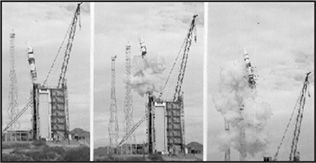
An experimental vertical shelter for the deployment of MX missiles was constructed at the Test Site. If the design had been adopted, the missile would have been placed in an 18-foot diameter, 130-foot-deep vertical silo. At launch the silo would have cut through a 40-foot layer of soil. The missile would then have been fired.
The Nevada Test Site was selected for several Air Force Peacekeeper (MX) research and testing experiments from 1978 through 1982.
U.S. Air Force, Westinghouse, Martin Marietta, Thiokol, EG&G Energy Measurements, Inc. (EG&G), Reynolds Electrical & Engineering Co., Inc. (REECo), and DOE employees worked on the project in the Area 25.
One of the first MX projects was the Vertical Shelter Ground System Definition Program which required REECo to build an 18- foot diameter, 130-foot deep vertical silo for missile loading and egress (exit) tests.
The egress mechanism was built to thrust a 348,000-pound simulated missile and canister out of the silo to a height of 40 feet above ground after it burst through a layer of soil weighing 50,000 pounds.
In other experiments, an extensive network of experimental roads was built to evaluate construction methods in native desert soils. Scientists needed to make sure the roads would accommodate the heavy loads associated with transporting 200 MX missiles among 4,600 shelters. These tests were part of the Multiple Protective Shelter System (more commonly referred to as the “shell game system” or “race track model.”
When the Carter administration decided to use the horizontal shelter basing mode, an extensive program was started to develop this design. The R.M. Parsons Company, proposed “precast” construction and the R.A. Hanson Company proposed a “cast-in-place” method.
The shelter segments used about 220 yards of concrete per segment and weighed between 240 and 300 tons each. Studies into this basing mode were canceled by the Reagan administration in October 1981.
Another extensive experiment was the MX Canister Assembly Launch Test Program (CALTP) designed to test MX missile launch parameters. This program required extensive rehabilitation and modification to the research and development facilities in Area 25.
Construction to support the tests involved building a 125-foot assembly and launch tower, camera towers, auxiliary test pads for gas generator tests and missile component handling, and installation of a 200-ton, stiff-leg crane to support the project operations.
The first of five launches in January 1982 was witnessed by 60 distinguished guests. A 71-foot-long, 92-inch-diameter, 195,000-pound missile, without propellants, was thrust more than 300 feet into the air at a 5-degree angle and nearly 100 feet down range into a large earthen pit.
In 1983, REECo miners used a 256-ton tunnel boring machine to drill a 750-foot tunnel into Little Skull Mountain as part of the project. The tunnel was later used by the Air Force to investigate equipment and methods for post-attack “dig-out” from underground missile complexes.
Peacekeeper Tests Related Document
Accident traps four workers 1,800 feet below ground
Over the past 42 years, the Nevada Test Site has earned an excellent safety record. Thousands of workers have completed millions of accident-free hours at this heavy industry site.
Since 1957 (no accurate records exist for 1951-56), there have been 46 fatalities on the Test Site, and six fatalities at other Test-Site-related locations.
Being safety conscious and prepared minimizes the impact of the occasional accident. The events of September 21, 1964, are an example. Although there was one fatality, cool heads and quick thinking saved the lives of four others in a dramatic 86-hour rescue effort.
The accident at Yucca Flat took the life of a Reynolds Electrical & Engineering Co., Inc. (REECo) employee and trapped four others 1,800 feet below ground.
A signal cable being lowered down a metal-cased vertical shaft 48-inches in diameter snapped at about 1,800 feet below ground. James C. Gray of Indian Springs, who was working on the surface, was fatally injured. Three other members of the surface crew were hurt.
The four men trapped below ground were unable to leave a small mined room at the bottom of the shaft when the lower section of the cable, weighing about 9,000 pounds, fell on top of the elevator cage in a broken and twisted mass.
The trapped men were Leland Roeder, George R. Cooper Sr., Art Luhnow, and Lloyd L. Shaw, all REECo employees.
The accident broke telephone lines to the cavity, but a new line was lowered down a 16-inch ventilation shaft along with food, beverages, blankets, and reading material.
Family and close friends of the trapped men were brought to the accident scene so they could talk to their loved ones.
A crew of approximately 35 men worked around the clock to clear the twisted and broken cable and hoist it to the surface.
The shaft was finally cleared on September 23, about 86 hours after the accident occurred. REECo co-workers William Flangas and Frank Solaegui were lowered to the bottom of the shaft to extract the trapped miners. The last worker was brought to the surface about five hours later.
Security played crucial role
Before Wackenhut Services Inc. (WSI) won the contract in 1965, Federal Services, Inc. provided security for the Nevada Test Site.
Although the mission of the security forces has not changed over the last 42 years, uniforms, communication equipment and vehicles are substantially different.
At 1,527 feet, BREN Tower dominates Test Site skyline
The BREN Tower, 1,527 feet tall, has been a focal point of attention ever since it was erected on the Nevada Test Site in 1962.
During its 30 years, it has been part of the Yucca and Jackass Flat skylines, and a platform for two important experiments – Bare Reactor Experiment, Nevada (BREN), and the High Energy Neutron Reactions Experiment (HENRE).
It was built by the Dresser-Ideco Company in Area 4 of Yucca Flat. Constructed of 51 thirty-foot sections of high tensile steel, the structure is higher than the Empire State Building’s 1,472 feet. It is supported by 5 1/2 miles of guy wires designed to withstand winds exceeding 120 miles per hour. The tower was equipped with an outside hoist to lift scientific equipment, and a two-person elevator inside the tower which moved at 100 feet per minute. The tower weighs 345 tons.
It was prefabricated and shipped to Nevada on nine trailer trucks.
The first experiment (from which the BREN tower got its name) was the Bare Reactor Experiment, Nevada. It was a major project of the Civil Effects Test Organization of the Atomic Energy Commission’s Division of Biology and Medicine. The experiment was designed to develop a way to accurately estimate the radiation doses received by selected survivors of the atomic bombings of Nagasaki and Hiroshima, Japan.
A small, unshielded (bare) reactor was mounted on the hoist car and moved to various heights up and down the tower. Japanese-type houses were built near the base of the tower and were bombarded with various intensities of radiation. The scientists wanted to determine what kind of protection the shelters provided from the radiation of atomic weapons.
As other studies were proposed for the tower, it became apparent that they would be incompatible with the underground testing program. On March 27, 1966, a $380,000 contract was awarded to the Dresser-Ideco Company, Columbus, Ohio, to dismantle the tower and move it to Jackass Flats in Area 25.
After the tower was erected at its new site, it was used for Operation HENRE (High Energy Neutron Reactions Experiment), a series of radiation measurement experiments using a small linear accelerator to provide neutrons. HENRE was a $600,000 experiment jointly funded by the AEC and the Department of Defense to develop information for the AEC’s bio-medical research program.
NASA’s Apollo astronauts use Test Site craters to prepare for Moon surface
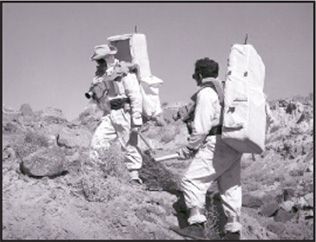
Because the “Schooner” and “Sedan” craters at the Nevada Test Site had features similar to the topography of Moon craters, astronauts used them to train for their missions.
Astronauts for Apollo 14 exercised at Schooner crater, and visited Sedan crater in November 1970. Apollo 16 astronauts visited the Schooner crater in November 1970, and exercised there in October 1971. Apollo 17 astronauts conducted exercises at Schooner and on Buckboard Mesa in August 1972.
Although the exercises at the NTS were only a small part of their training, voice transcripts of the Apollo missions show that their work at NTS craters contributed to astronaut performance on the Moon.
Astronaut H.H. Schmitt referred to “Little Dan” crater (named by astronauts) on Buckboard Mesa while describing a 600-meter lunar crater in the Haemus Mountains west of Sulpicius Gallus.
Apollo Astronauts Related Document
Protestors dress style changes; message doesn’t
The nuclear testing program has generated a lot of publicity during its 42- year history. Much of the publicity has not been kind to the thousands of Nevada Test Site employees.
Numerous anti-nuclear activists have vented their anger at the Department of Energy (DOE) and its predecessors, the Atomic Energy Commission, Energy Research and Development Administration.
While their message “stop nuclear testing” has not changed over the years, the delivery of that message and the attire of the nuclear activists have changed.
Countless activists have confronted Test Site public affairs officers and security officials in Las Vegas and at the Nevada Test Site. Fortunately, there have been no serious injuries during the incidents.
Smoky
On August 31, 1957, “Smoky,” a 44-kiloton device, was detonated from atop a 700-foot tower in the northern section of the Nevada Test Site.
The test, to validate a particular nuclear device design, allowed the Department of Defense to test tactical concepts for potential atomic warfare situations.
About 700 soldiers participated in the military exercise. Two unmanned M-48 tanks also were used. The tank placed 1,231-feet from ground zero was rolled over by the blast and suffered extensive damage, while the tank at 2,800 feet away remained intact.
The Smoky test also provided information on impacts of a detonation in a hill-and-dale terrain.
Tunnel tests span 35 years of Nevada Test Site history
On August 10, 1957, a zero-yield safety experiment named “Saturn” was detonated in C-Tunnel. Since then tests have been conducted in 16 different tunnels in Rainier Mesa on the Nevada Test Site. Today, there is only one active tunnel used by the Defense Nuclear Agency (DNA).
The DNA evaluates the effects of nuclear weapons explosions, thermal radiation, blast, shock, x-rays and gamma rays, on military hardware, such as communication equipment, rocket nosecones, and satellites.
The typical Horizontal Line of Site (HLOS) test is primarily for radiation effects research. Researchers attempt to minimize blast and shock effects from the experiments. A large tunnel complex mined under the mesa contains the HLOS pipe. The HLOS pipe is 1,500 to 1,800 feet long and tapers from up to 30 feet in diameter at the test chamber to several inches at the working point.
Experiments are placed in the HLOS pipe test chambers. At zero time, the nuclear device is fired, and radiation instantaneously flows down the pipe, creating the necessary radiation environment.
To prevent bomb debris and blast from reaching and damaging the experiments, three mechanisms are used to close the pipe. The first is the Fast Acting Closure which is slammed shut by high explosives in about one millisecond; the other two closures follow within 30 and 300 milliseconds.
Once the tunnel is declared safe by Radiological Safety personnel, usually two days after the test, workers reenter the tunnel to recover the experiments.
Huron King
A rare type of Vertical Line of Sight (VLOS) underground test was conducted by the Defense Nuclear Agency on June 24, 1980.
The “Huron King” test used a nuclear device of less than 20 kilotons.
The VLOS design involved placing the nuclear device at the bottom of the shaft with a communications satellite and other experiments in an above-ground test chamber to simulate a space environment.
At zero time, the radiation from the device flowed up the vertical pipe to the surface test chamber. Mechanical closures then intercepted and sealed the pipe, preventing the accompanying shock wave from damaging the targets.
The test chamber was then immediately disconnected by remote control from the pipe and winched to safety before the ground subsided to form a crater.
Nuclear Rocket Development Station tested nuclear rocket for Mar mission
In the mid-1950s, the United States initiated a nuclear rocket program called “Project Rover.”
The NTS was selected to test nuclear reactors and engines, and perform various ground tests. The tests, performed in the southwest corner of NTS (Area 25), ended in 1972.
The Atomic Energy Commission (AEC) and the National Aeronautics and Space Administration (NASA) Space Nuclear Propulsion Office jointly administered the test area – subsequently designated as the Nuclear Rocket Development Station (NRDS).
During the life of its operation, more than $100 million was spent on facility construction and equipment. The NRDS consisted of test cells, “A,” “C,” and ETS-1 Engine Test Stand; R-MAD and E-MAD (Reactor and Engine Maintenance Assembly and Disassembly facilities; a Control Point/Technical Operations complex; an administrative area; and a radioactive material storage area.
The three test cell areas were connected by road and railroad to the R-MAD and E-MAD buildings.
The Rover Program successfully demonstrated that a nuclear reactor could be used to heat liquid hydrogen for spacecraft propulsion.
The “Kiwi,” “Phoebus,” “Peewee” and “Nuclear Furnace” series were developed and tested to understand the basics of nuclear rocket reactor technology. The reactors, designed to study high-temperature fuels and long-life fuel elements, were operated with increasingly greater specific impulses, power levels, and power densities.
Rover also included the Nuclear Engine for Rocket Vehicle Application (NERVA) program, a technology demonstration effort to determine the characteristics of the NERVA Reactor Experiment and Ground Experiment Engines (an outgrowth of the “Kiwi” reactor series) during start up, full power, and shutdown conditions.
Based on results of those demonstrations, scientists began designing a nuclear rocket using a high-power, high-thrust NERVA engine and a low-power, low-thrust, small engine. These designs were for the in- flight test program.
In 1969, the United States abandoned plans for human exploration of Mars. The Rover Program was subsequently canceled in 1972. Today there are indications of renewed interest in development of a nuclear rocket engine for deep space missions.
Unique 36-acre experimental farm tested crops, animals
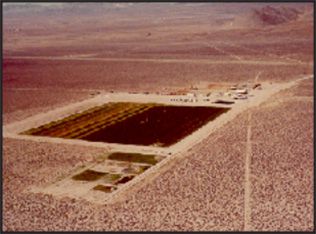
For 15 years, the U.S. Environmental Protection Agency (EPA) managed a unique, 36-acre experimental farm for the U.S. Department of Energy and its predecessor agencies.
Construction of the farm began in 1964 in Area 15 of the Nevada Test Site. The land was cleared of desert vegetation, a 5,400-foot water well was rehabilitated, a one-million-gallon reservoir was built, and the first crops were planted.
During the next two years, dairy facilities were added: several large open paddocks, individual shaded stalls, and a combination milking barn/main laboratory building.
Extensive plant and soil studies evaluated the uptake of pollutants in farm- grown vegetables and forage the diary herd of some 30 Holstein cows. Scientists also studied horses, pigs, goats, and chickens.
EPA also managed a herd of 100 Hereford beef cattle. Four of the animals gained fame as “fistulated steers” (animals with surgical openings in their sides). The steers were part of a special research project and served as biological samplers of the forage consumed by the rest of the herd as it ranged over the northeast corner of the Test Site.
The farm was closed in 1981 because no more useful data was being obtained. The researchers found no disease or tissue damage in the cattle due to radiation exposure. Radiation levels that were detected in the tissue samples were well within excepted Federal standards.
Frenchman Flat
Between January 27, 1951, and March 25, 1968, 14 atmospheric and five underground tests were detonated at Frenchman Flat. The 320-square-kilometer (123-square- mile) dry lake bed is one of three major closed desert valley basins at the Nevada Test Site, the others being Yucca and Jackass Flats.
From 1953 to 1958, reinforced structures were exposed to of nuclear blasts and accompanying overpressures. Among the items exposed to the blasts were French-and German-designed shelters, a Mosler safe, a railroad bridge, butler buildings (hangers), a man-made pine tree forest planted in concrete blocks, railroad rolling stock, tanks and other items of military equipment.
Since 1982, more than 47,000 visitors have toured Frenchman Flat to view the historic structures and twisted ruins, which stand as stark testimonial to the awesome power of the atom.
Underground testing perfected big-hole drilling technology
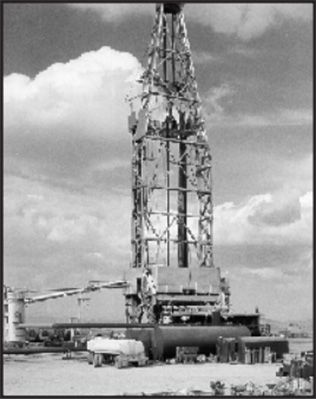
On July 26, 1957, a safety experiment called “Pascal A” was detonated in an unstemmed hole. Although the test was not spectacular, it does hold the distinction of being the first nuclear test in the world to be detonated underground.
From 1957 to 1992, 533 contained tests and nine unstemmed tests were conducted at the NTS.
If the depths of all the 36-inch diameter holes drilled for nuclear tests were added together since 1961, they would total about 280 miles.
Big-hole drilling (holes larger than 36 inches in diameter) so essential to the nation’s testing program, was not invented at the NTS. As early as 1850, 30-inch water wells were drilled in the eastern and midwestern United States by rotary rigs. In 1927, the Dutch were drilling 216-inch diameter holes to construct levees to reclaim land from the sea.
The need to drill large-diameter holes at NTS resulted from the Limited Test Ban Treaty (TTBT), signed in Moscow on August 5, 1963. The TTBT prohibited testing nuclear weapons in the atmosphere, underwater, and in outer space. As a result, scientists from the DOE weapons laboratories had to place all their test packages underground.
To accomplish this, employees of Reynolds Electrical & Engineering Co., Inc. (REECo) developed innovative drilling techniques to overcome the problems of a penetration rate that was too slow and therefore too costly, terrain that was too porous, the need for straight line-of-sight holes, and the need to have a hole wide enough to accommodate the test package.
Today, REECo’s drilling techniques and hardware are used throughout the world to construct bridge piers and make platforms for ocean drill rigs.
When REECo began drilling at the NTS in 1959, the biggest problem was the time it took to drill into the desert floor. A 36-inch diameter hole, 1,000 feet deep, could take up to 60 days. The initial method was to drill in three successive passes, each one larger. This time-consuming process was reduced somewhat when REECo mounted all three bits together, in a tri-stage simultaneous drilling setup. Even with this innovation, the drillers worked 30 days to complete a hole.
Successive modifications stacked the bits closer together. Eventually the tri-stage gave way to the flat bottom bit, with 12 to 24 cutters chewing up the rock as the entire unit rotated.
Still needing to speed up the process, drillers increased the weight of the bit using split donut weights stacked on mandrels. The initial weight of this assembly was about 300,000 pounds. This meant the workers could drill a 1,000-foot hole in 20 days.
Today, the 90-inch weights weigh 27,500 pounds each. Usually, drilling takes place with 8 to 10 weights stacked on top of each other, for a total weight of 450,000 pounds.
For every foot drilled with a 96-inch bit, more than 50 cubic feet of cuttings have to be removed from the hole. The problem of getting rubble chewed up by the cutters from working level to the surface while the porous ground is absorbing the moisture injected to carry those materials, was solved by the dual string-airlift reverse circulation system.
In simple terms, dual string- airlift reverse circulation requires a 13-3/8 inch pipe into which a smaller 7-inch pipe has been inserted. Water is pumped down between the inner and outer pipes, circulates over the cutters, collects the ground-up rubble and then sucks it to the surface through the 7-inch pipe using airlift pumping.
A line-of-sight drill hole is essential to prevent the diagnostic package with the test experiments from binding or catching on the sides of the hole. With a drilling assembly weight of 250,000 pounds, 100,000 pounds is supported by the bit and 150,000 pounds is suspended by the drill pipe to keep the hole straight and plumb.
Big Hole Drilling Related Document
Yucca Mountain studies authorized in 1976
In 1982, Congress passed the Nuclear Waste Policy Act (NWPA) to set national policy to help solve the issue of high-level nuclear waste disposal. Congress based this law on a concept that most scientists agreed was the best way to dispose of nuclear waste.
The NWPA made the U.S. Department of Energy (DOE) responsible for locating, building, and operating an underground geologic repository for the permanent disposal of high-level nuclear waste.
The quest for a geologic repository dates back to 1957 when the National Academy of Sciences recommended that the best means of protecting public health and safety, and the environment, would be to dispose of high-level waste deep underground in rock. Scientists evaluated many options, including burying it under the ocean floor, disposal under the polar ice sheets, and sending it into outer space.
The NWPA established a detailed schedule for site characterization. To pay for the program, Congress established the Nuclear Waste Fund. People who use power from nuclear plants pay into the fund for nuclear waste disposal through their utility bills.
In 1976, nearly 20 years after the first nuclear power plant went online, the government began collecting data on potential repository sites. The 1982 Act was based on what was learned during the earlier program.
In 1983, DOE selected nine locations in six states to consider for potential high-level radioactive waste storage sites.
All the sites were studied, and the findings were submitted to Congress. Based on the studies, President Reagan then approved three sites for comprehensive characterization: Hanford, Washington; Deaf Smith County, Texas; and Yucca Mountain, Nevada.
In December 1987, Congress amended the NWPA and directed DOE to study only Yucca Mountain. This congressional mandate, driven by budgetary concerns and the costs of studying three sites, was criticized by some Nevadans who felt the 1987 Amendments Act unfairly targeted the state to eventually receive the waste.
In the Amendments Act, Congress directed DOE to determine whether or not Yucca Mountain would be suitable for a potential repository. The Act specifies studies will stop immediately if Yucca Mountain is found unsuitable. If that were to happen, the site would be restored to its natural condition and DOE would seek new direction from Congress.
From 1976 to 1986 various site characterization studies were conducted. These included drilling boreholes to obtain information on the mountain’s hydrology and earthquake faults.
In 1986, all surface-disturbing activities were stopped on the Yucca Mountain Project. The State of Nevada stated that Yucca Mountain work could not be done under standing NTS permits.
On July 8, 1991, project scientists resumed digging at Trench 14 in the Midway Valley in the southwestern area of the Nevada Test Site, after obtaining the required air quality permit from the State of Nevada. This was followed on March 3, 1992, by the insurance of a water permit, which allowed water to be pumped for dust control.
On June 29, 1992, an earthquake below Little Skull Mountain registered 5.6 on the Richter Scale. Because it was only 12 miles from Yucca Mountain, the earthquake revived concerns about the site.
Scientists have found that information from the quake is invaluable in helping them understand ground motion that may occur with future quakes. This will provide clues to the suitability of the mountain.
In November 1992, work began on the Exploratory Studies Facility (ESF). The ESF will be a technically designed underground laboratory consisting of a 14-mile loop of tunnels on two levels with a north entrance ramp, a main cross tunnel, and a south exit ramp. Alcoves will house individual laboratory and test facilities 1,000 feet below the mountain ridge.
Once the studies are completed (target date is 2001) the findings will be submitted to the Secretary of Energy, who will then recommend appropriate action to the President. If the site receives Presidential approval, DOE will seek a license from the Nuclear Regulatory Commission to begin construction. The state of Nevada will have an opportunity to submit a “notice of disapproval” (veto) after the Presidential decision. Work could only continue if a majority vote in Congress overturned the State’s veto.
Emergency response personnel conduct joint exercise
Approximately 650 people from the Department of Defense and Department of Energy took part in a 1981 weapons accident training exercise, in Area 25 of the Nevada Test Site. The purpose of the exercise was to put into action a planned response to a nuclear accident.
The scenario involved a simulated crash of an Army helicopter transporting nuclear weapons to a storage site. The helicopter crashed near the fictitious town of Wahomie, and the crash scattered radioactive material over a portion of the mock town set up in Area 25. To ensure realism, small radioactive radium-223 and mercury-197 sources were hidden for searchers to locate.
The exercise was also the first federally-sponsored nuclear weapons accident exercise with participation from the Federal Emergency Management Agency and the State of California.
